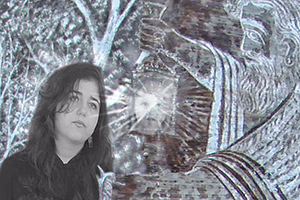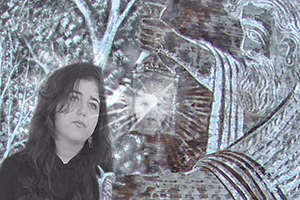
If you think a visit via deep meditation to the “Inner You” might be a pleasant stroll in the park, the Russian composer Lera Auerbach will tell you otherwise. Her new string symphony, Memoria de la Luz (“Memory of the Light”), is definitely not 22 minutes of humming “Om” in the lotus position. In the transformative rather than the psychedelic sense, it’s more like astronaut Bowman’s final ride in Kubrick’s 2001.
Just by translating the Spanish titles of its movements, “Primordial Light,” “Monologue,” “Four Questions,” “Ecstatic Dialogue,” “Tragic,” and “Epilog,” you know you’re in for something Significant. Turning to Auerbach’s fogbank of program notes about “the lost harmony of the primordial light,” “the sacrament of the primordial melody of losses,” and the “loss before birth,” you wonder if she munches Metaphysicschex for breakfast.
But then comes the music. Namely, one of the finest new chamber works I’ve heard in a long time, superbly realized by Music-Director-1st-violinist-conductor Nadia Salerno-Sonnenberg and her New Century Chamber Orchestra team.
I’m accustomed to the expertly spirited, athletic, and punctuated qualities the NCCO normally brings to their endeavors, but Thursday evening at Berkeley’s First Congregational Church a new talent was revealed: supreme delicacy and restraint. Memoria begins with all instruments playing ethereal harmonics, many in very high registers. This is something difficult to sustain over long periods without slipping off pitch, but the NCCO finessed Auerbach’s requirements into magical results.
I’m accustomed to the expertly spirited, athletic, and punctuated qualities the NCCO normally brings to their endeavors ... but a new talent was revealed: supreme delicacy and restraint.
The “Monólogo” and “Cuatro preguntas” movements featured yearning line from soloists on viola, violin, and cello accompanied by gossamer tremolos and pizzicatos. Many minutes of these evocations led to the “Diálogo extático” and enthralling cello phrases paired with shrieking violin tremolos. These built to an even more intense “Trágico” with burned-in pedal points hammering cascades of fifths in the violins.
The effect was like being slowly hypnotized, and then deciding it’s a good idea to crawl into a washing machine, drop some quarters in, and shut the lid on yourself. You emerge in the “Epilogo” cleansed, but bruised.
Memoria de la Luz was commissioned by the NCCO and supported by the Clarence E. Heller Charitable Foundation. Salerno-Sonnenberg hinted that it may appear on the NCCO’s next CD release. Don’t miss it!
The performance techniques engendered by Auerbach’s new work seemed to carry on into the next piece on the program, Wagner’s Siegfried Idyll. Never have I heard a more caring and intimate rendition of this music, which in its original chamber version properly evokes the circumstances for which it was written—a beloved wife’s birthday, not a hero slaying a dragon.
After intermission came a fine performance of Haydn’s “Farewell” Symphony No. 45 in F-sharp Minor. The opening Allegro and the first half of the Finale were delightfully brisk. I had a little trouble with the horns in the other movements: They were exemplary in the Wagner, but seemed too loud in the Haydn.
Although humorist Haydn directed only that orchestra members leave the stage during the second half of the “Farewell” finale, the orchestra members added some dramatizations of their own to their departures. Some checked their cell phones on their way off the stage. Others set their instruments down with exaggerated shrugs. Some pointedly checked their watches several times before heading out. Violist Kurt Rhode marched off with his music stand. It was all great fun, and an appropriate way to say goodbye to an illustrious season.
It should take zero soul-searching for anyone to decide whether or not to renew acquaintance with this fabulous orchestra next season—even if the next concert has a piece called “Viola Zombie.” It’ll be a delicate zombie, for sure!

